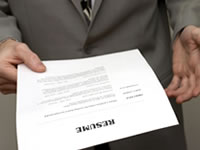
Founder of CareerAlley
A printed resume is something every job seeker should have on hand, and it is one way to demonstrate your professionalism. Don’t assume that the interviewer will have a copy of your resume (although they should), bring several printed resumes with you (even if you only plan to see one person). Your resume is probably the first thing a potential employer will see before interviewing you, it’s essential to print it in a way that is crisp and professional.
[Related: 6 Tips to Get a Resume that Works for You]
Printing a Professional Resume
- Paper – Use high-quality paper. You can purchase resume paper, which is a bit thicker and more textured than normal printer paper, from office supply stores. Although it is more expensive than regular paper, it will make an immediate impression on potential employers.
- No Rainbows – Unless you are interviewing for a creative position, you resume should be printed with black ink only. Avoid the temptation to add any colored fonts to your resume, which not only looks unprofessional, but could also make the resume harder to read, especially if the individual reading it has poor vision. Avoid the temptation to use gray hues. Although they’re not technically colors, mixing gray in with black lettering will make the resume look unprofessional and clunky.
- Use a Quality Printer – High quality paper and great content won’t help if you print your resume on a low quality printer. Print your resume with a laser printer if possible. While an inkjet printers are generally fine for printing resumes, the ink can smudge and may run if it gets wet. Resumes printed with laser printers will have ink that is less vulnerable to smudging, and that won’t run as easily if the potential employer gets it wet at some point.
- Keep it Flat – Keep your resume crisp, avoiding any creases or dents in the paper. The easiest way to keep your resume in good shape and ensure that it ends up in hiring manager’s hands unscathed is to transport it in a hard, thick folder. While you can use a resume folder (which is a sophisticated folder created specifically for this purpose) a regular file folder should serve the purpose.
- No Crazy Fonts – Use a standard business fonts. Helvetica, Ariel, Times New Roman or courier fonts are all fine. Although more modern fonts can be used as long as they are readable and don’t get in the way of the text. Avoid using a mix and match of multiple fonts, which can cause eye strain, and will make the resume look unprofessional. Avoid using “fancy” fonts and NEVER use Comic Sans!
- Formatting – There are a variety of formats you can use for your resume. While you can create a hybrid of formats you should avoid creating a format that is entirely unique or different by using a relatively obscure formatting. This practice will not make you look creative, but it will make you stand out – for the wrong reasons. Maintain a visage of professionalism by using a standard resume format.
- Visually Appealing – Your resume should remain consistent throughout the document. Avoid using more than one type of formatting, which will look messy and confusing and will cause the hiring manager to think that you did a haphazard job of putting together a resume. If the resume spans multiple pages, be sure that the formatting is the same on each page.
- Printing – Only print on one side of the paper. It may be tempting to print a multiple-page resume on both the front and back of the paper to save money (or trees), especially if you’re using expensive resume paper. While the intention is good, this practice will make it difficult for someone to scan through your resume, and appears unprofessional.
This article was written by Joey Trebif at CareerAlley and was republished with permission.
Comments are closed.